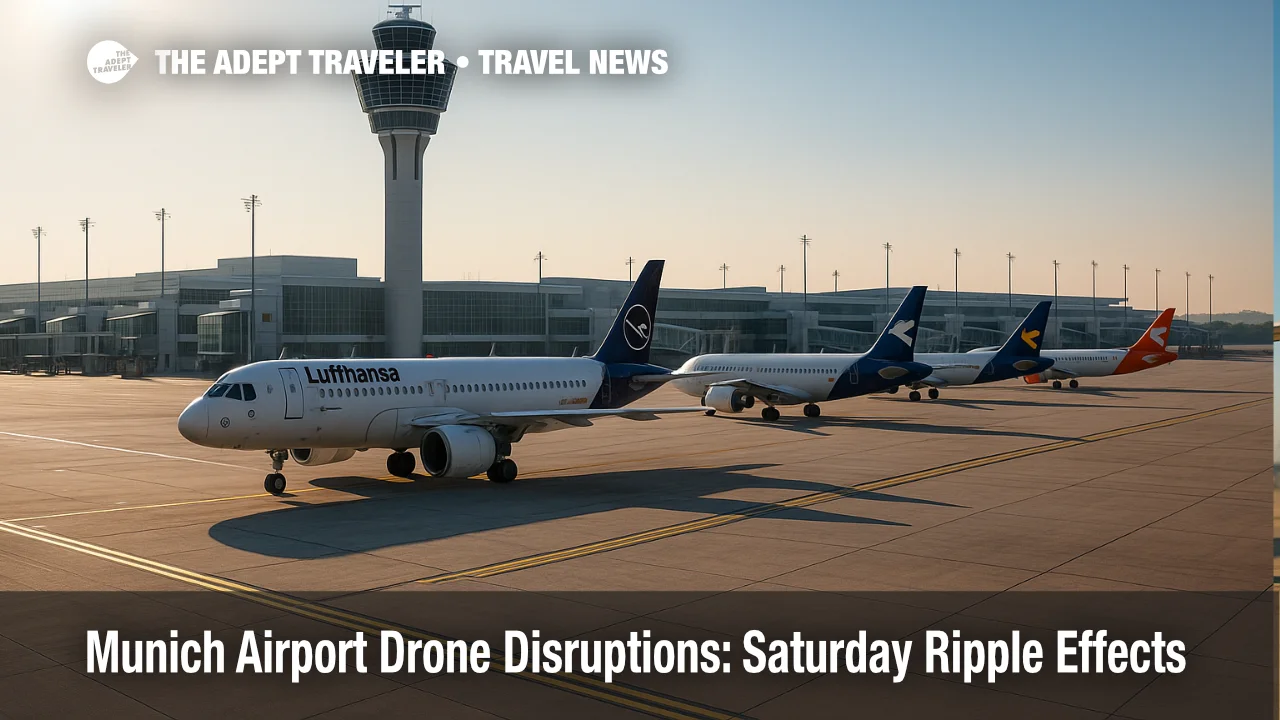Munich Airport drone disruptions: Saturday ripple effects

Munich Airport (MUC) restored operations on October 4, 2025 after a third drone-related shutdown in as many days, but the late-night stoppage bled into Saturday schedules. Rolling delays, diversions, and crew legality issues left aircraft and flight teams out of position, creating gaps in rotations and tighter turns at some gates. Travelers faced sporadic cancellations, longer minimum connection times, and last-minute equipment swaps. The airport and airlines said operations ramped through the afternoon, with additional recovery work planned overnight. If no further sightings occur, stabilization should improve by late Sunday morning, though early-wave departures may still feel residual strain.
Munich airport: second-night drone shutdown and European airport drone disruptions: what travelers should know
Key points
- Why it matters: Day-three knock-ons affected crews, aircraft, and connections.
- Travel impact: Early Sunday banks may see scattered delays and a few cancellations.
- What's next: Expect improving on-time performance if no new drone sightings emerge.
- Rebooked passengers should monitor crew duty windows and revised ETDs.
- Gate or equipment swaps likely on tight inbound-to-outbound turns.
Snapshot
Airport officials confirmed multiple drone sightings near Munich Airport on the evenings of October 2 and 3, with further sightings early October 4 that delayed Saturday's start. Operations resumed and gradually stabilized during the afternoon, but overnight aircraft positioning and crew legality left lingering bottlenecks. Lufthansa warned customers to expect day-long delays and isolated cancellations while schedules reset. Media tallies put Friday night's impact around 6,500 passengers, after roughly 3,000 were affected in the prior closure. Authorities reiterated that safety and verification protocols require temporary halts when drones are suspected near runways or approach paths, which can quickly ripple across a banked hub operation.
Background
Munich's back-to-back closures followed confirmed drone sightings near both runways late October 3, a day after an initial overnight shutdown. Germany's federal police and air navigation service restricted, then suspended operations during the incidents, diverting or canceling flights until risk assessments supported a restart. The interruptions landed during a peak travel period, complicating crew rosters and EU-mandated duty limits. Similar unexplained drone events have hit several European airports in recent weeks, prompting calls for tighter counter-UAS coordination and faster interdiction tools. While investigations continue, airport and airline guidance has focused on practical steps for travelers, including checking status repeatedly, traveling with carry-on where possible, and padding connection buffers through Sunday's early waves.
Latest developments
What to expect Sunday at MUC
Airlines spent Saturday afternoon repositioning aircraft and rebuilding rotations, but some equipment and crews will still start Sunday in the wrong place. That increases the odds of morning delays, especially on first-wave departures feeding European and long-haul banks. Tight inbound-to-outbound turns are most vulnerable to rolling tardiness, so travelers should watch for last-minute gate changes and aircraft substitutions. Lufthansa's advisory highlights the potential for isolated cancellations as schedules normalize. If authorities report no further drone activity overnight, on-time performance should improve toward late morning and midday. Practical move tonight: confirm your booking before bed, enable airline app alerts, and re-check at wake-up. If you were rebooked via another hub, keep an eye on crew duty windows that can push estimated times of departure.
Analysis
Three consecutive days of drone-related interruptions exposed how sensitive hub operations are to even short safety stoppages. Munich's schedule relies on tightly timed arrival and departure banks, with aircraft rotations and crew pairings stacked in sequence. A late-night ground stop breaks those sequences at the worst possible moment, when crews are nearing duty limits and spare capacity is thin. The result is a two-step recovery: restore the airfield, then unwind the cascade of mispositioned aircraft, crew legality resets, and maintenance intervals. Saturday's pattern-gradual ramp-up and stabilization by afternoon-fits that playbook. For Sunday, the risk shifts from mass cancellations to localized friction: a few first-wave delays, some missed connections, and equipment swaps where a tail misses its slot. Systemically, Germany's push for stronger counter-UAS authorities and a coordinated defense center suggests policy movement is coming; near-term, travelers should build redundancy into plans and use airline apps for live reassignments and mobile reissuance.
Final thoughts
Assuming no new sightings, Sunday at Munich should trend steadier after the first banks cycle through, with remaining headaches concentrated in tight turns and rebooked itineraries. Travelers who verify status tonight, travel light, and arrive early can blunt most residual risk. Watch crew legality-driven pushes on early flights and expect occasional gate or aircraft changes as rotations realign. If further drone reports surface, expect precautionary pauses and renewed knock-ons. Barring that, on-time performance should improve through late morning as the operation resets from the Munich Airport drone disruptions.
Sources
- Press: Drone sighting at Munich Airport, Munich Airport
- Germany's Munich Airport reopens after second closure in less than 24 hours, AP News
- Drone sightings delay Saturday flight operations at Munich Airport, Reuters
- Current travel information, Lufthansa
- Germany's Munich Airport reopens after closures due to drone sightings, PBS NewsHour
